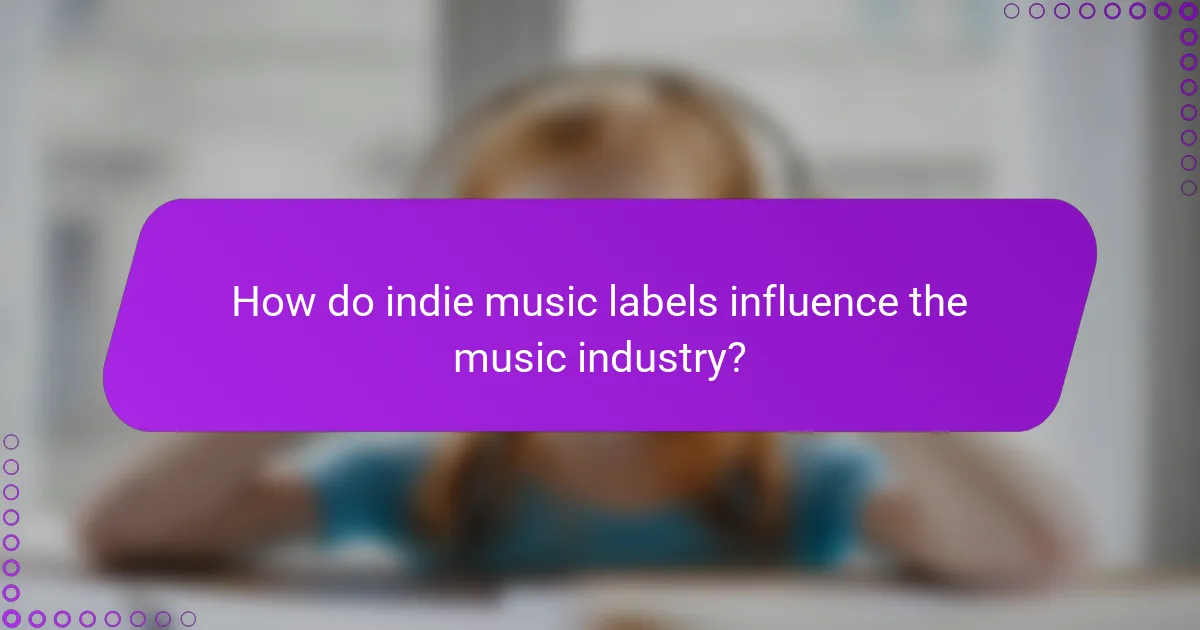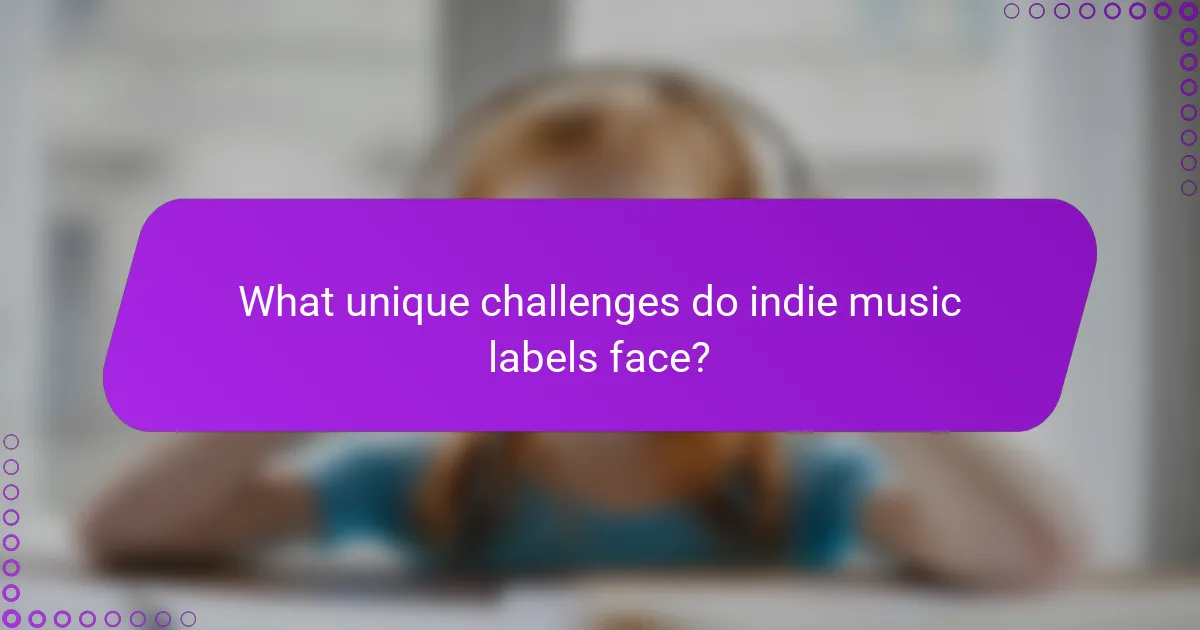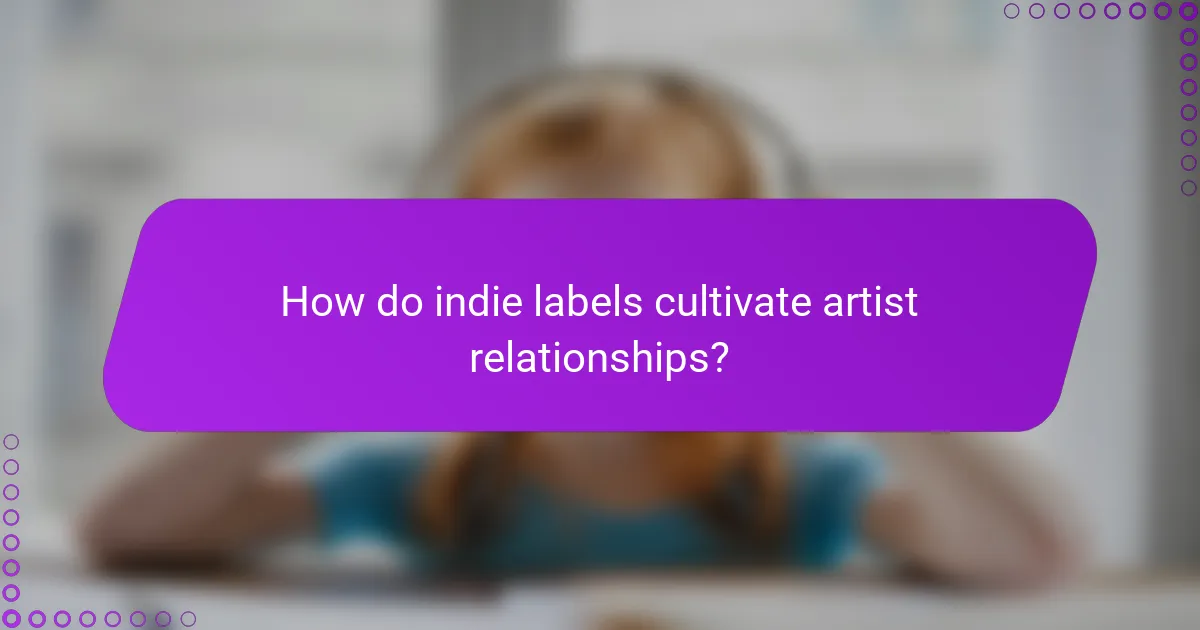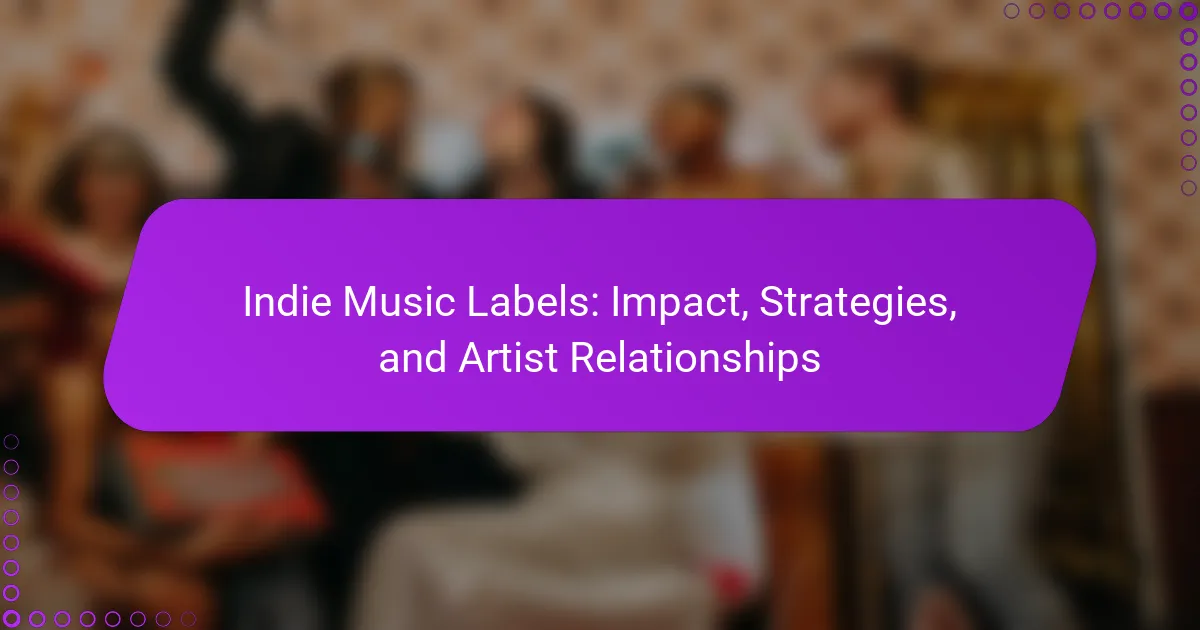Indie music labels significantly shape the music industry by promoting diverse sounds and supporting artist creativity. They face challenges like limited resources and competition from major labels. This article explores their unique strategies, the importance of artist relationships, and how digital platforms influence their success. Additionally, we will discuss best practices for navigating the evolving landscape of indie music.

How do indie music labels influence the music industry?
Indie music labels significantly influence the music industry by promoting diverse sounds and fostering artist creativity. They provide platforms for emerging talent, allowing artists to maintain creative control. This autonomy often leads to innovative music that challenges mainstream norms. Additionally, indie labels prioritize direct artist relationships, enhancing engagement with fans and building dedicated followings. Their unique marketing strategies often leverage social media and grassroots efforts, distinguishing them from major labels. As a result, indie music labels play a crucial role in shaping industry trends and diversifying the music landscape.
What are the key characteristics of indie music labels?
Indie music labels are characterized by their artist-centric approach, creative freedom, and niche market focus. They prioritize fostering unique sound and identity over commercial success. Many indie labels operate on limited budgets, leading to innovative marketing strategies and community engagement. Their relationships with artists often emphasize collaboration, allowing for greater artistic expression and control.
Why do artists choose indie labels over major labels?
Artists often choose indie labels over major labels for greater creative control and personalized support. Indie labels typically offer more flexibility in artistic direction, allowing artists to maintain their unique sound and vision. They often foster closer relationships, providing tailored marketing strategies and a more engaged fan base. Additionally, indie labels tend to have fewer bureaucratic hurdles, enabling quicker decision-making and adaptability to market changes. As a result, many artists find indie labels align better with their values and career goals.
How do indie labels support artist development?
Indie labels support artist development through personalized guidance, financial investment, and creative freedom. They provide resources like recording, marketing, and distribution, allowing artists to grow their skills and audience. This approach fosters unique sounds and artistic expression, which distinguishes them from mainstream labels. Indie labels often prioritize long-term relationships, ensuring artists receive ongoing support throughout their careers.
Which strategies do indie labels employ for marketing and promotion?
Indie labels employ diverse strategies for marketing and promotion, focusing on grassroots efforts and digital platforms. They utilize social media to engage audiences, often collaborating with influencers for broader reach. Direct artist-to-fan communication through newsletters and concerts fosters loyalty. Additionally, indie labels leverage streaming services for visibility, curating playlists that highlight their artists. Unique branding and storytelling enhance the emotional connection with listeners.

What unique challenges do indie music labels face?
Indie music labels face unique challenges including limited financial resources, competition from major labels, and difficulties in artist promotion. These factors hinder their ability to scale operations and reach wider audiences. Additionally, indie labels often struggle with distribution and marketing, which affects their artists’ visibility in a crowded market. The reliance on digital platforms can also create challenges in navigating algorithms and trends.
How do funding and resources impact indie label operations?
Funding and resources significantly influence indie label operations by determining their capacity for artist development, marketing, and distribution. Adequate financial backing enables labels to invest in quality production and promotional strategies, enhancing artist visibility. Limited resources can hinder growth, affecting artist relationships and overall label sustainability. For instance, labels with strong funding can offer better contracts and support, while those with fewer resources may struggle to compete. This disparity illustrates how financial health directly correlates with operational success in the indie music landscape.
What role does digital distribution play for indie labels?
Digital distribution is crucial for indie labels as it provides wider reach and greater accessibility for their artists. Through platforms like Spotify and Bandcamp, indie labels can distribute music globally without significant upfront costs. This democratization of music access allows indie artists to connect directly with fans, enhancing artist relationships. Additionally, digital analytics empower labels to understand audience preferences, optimizing marketing strategies. Overall, digital distribution transforms how indie labels operate, fostering growth and innovation in the music industry.
How do indie labels navigate legal issues and contracts?
Indie labels navigate legal issues and contracts by prioritizing clear communication and understanding of rights. They often work with legal professionals to draft fair agreements that protect both the label and the artist. This collaboration ensures that contracts outline revenue sharing, ownership rights, and distribution terms. Additionally, indie labels may utilize standardized contracts to streamline negotiations while allowing for unique clauses that reflect individual artist needs. This approach fosters strong relationships and trust between the label and artists, essential for long-term success in the music industry.

How do indie labels cultivate artist relationships?
Indie labels cultivate artist relationships through personalized support and transparent communication. They prioritize artists’ creative visions, offering tailored marketing strategies and financial guidance. This approach fosters trust and collaboration, essential for long-term success. Additionally, indie labels often provide networking opportunities, connecting artists with industry professionals and peers. This unique attribute enhances artists’ visibility and growth in a competitive market.
What are the benefits of long-term partnerships with artists?
Long-term partnerships with artists provide numerous benefits, including enhanced creative collaboration, consistent branding, and mutual growth. These relationships foster trust, leading to innovative projects and increased audience engagement. Additionally, indie music labels can leverage established artist followings to expand their reach and market presence. This synergy often results in higher quality music and sustained career development for both parties.
How do indie labels foster creative freedom for artists?
Indie labels foster creative freedom for artists by providing flexible contracts and personalized support. They prioritize artistic expression over commercial pressures, allowing musicians to explore diverse styles. This environment encourages innovation and authenticity, resulting in unique music that resonates with audiences. Additionally, indie labels often maintain closer relationships with their artists, fostering collaboration and open communication. Such dynamics empower artists to make decisions that align with their vision and values.
What communication strategies are effective in artist-label relationships?
Effective communication strategies in artist-label relationships include transparency, collaboration, and regular feedback. Labels should establish open channels for dialogue, allowing artists to express creative ideas and concerns. Regular check-ins foster trust and alignment on goals, enhancing mutual understanding. Additionally, labels can leverage digital platforms for real-time updates and project tracking, ensuring both parties remain informed and engaged. These strategies strengthen the partnership, leading to successful outcomes.

Which trends are shaping the future of indie music labels?
Indie music labels are increasingly influenced by digital distribution, artist-centric strategies, and genre diversification. Digital platforms enable wider reach and direct artist-to-fan engagement. Labels focus on nurturing artist relationships through personalized marketing and collaborative projects. Additionally, the rise of niche genres fosters unique soundscapes and diverse talent, reshaping the indie music landscape.
How is technology changing the landscape for indie labels?
Technology is transforming the landscape for indie labels by enhancing distribution, marketing, and artist engagement. Digital platforms allow indie labels to reach global audiences without traditional barriers. Streaming services provide valuable data analytics, helping labels understand listener preferences. Social media enables direct artist-fan interactions, fostering loyalty and community. Moreover, affordable production tools empower artists to create high-quality music independently. This evolution supports unique branding strategies, allowing indie labels to differentiate themselves in a competitive market.
What impact do social media and streaming platforms have?
Social media and streaming platforms significantly enhance the visibility and reach of indie music labels. These platforms enable artists to connect directly with audiences, fostering engagement and community. Streaming services provide analytics that help labels understand listener preferences, guiding marketing strategies. Social media allows for real-time interaction, promoting new releases and events effectively. As a result, indie labels can cultivate dedicated fan bases and increase revenue streams through merchandise and concert sales.
Which emerging markets are becoming significant for indie labels?
Emerging markets such as Brazil, India, and Nigeria are becoming significant for indie labels. These regions showcase a growing appetite for diverse music styles and independent artists. Brazil’s vibrant cultural scene supports local talent, while India’s digital music consumption is rapidly increasing. Nigeria’s Afrobeat genre is gaining international recognition, creating opportunities for indie labels to thrive.

What best practices can indie labels adopt for success?
Indie labels can adopt several best practices for success, including building strong artist relationships, leveraging digital marketing, and diversifying revenue streams. Fostering transparent communication with artists enhances trust and collaboration. Utilizing social media and streaming platforms effectively increases visibility and audience engagement. Additionally, exploring merchandise sales and live events can create new income opportunities, ensuring financial stability.
How can indie labels effectively build a brand identity?
Indie labels can effectively build a brand identity by focusing on authenticity, community engagement, and consistent messaging. They should define their unique sound and aesthetic, creating a recognizable image that resonates with their target audience. Collaborating closely with artists fosters genuine relationships, enhancing the label’s reputation and appeal. Utilizing social media for storytelling and audience interaction further solidifies the brand’s presence. Additionally, hosting local events and supporting grassroots movements amplifies community ties, establishing a loyal fan base.
What strategies enhance audience engagement for indie artists?
Indie artists can enhance audience engagement through authentic storytelling, social media interaction, and live performances. These strategies create a personal connection, making fans feel part of the artist’s journey. Consistent content sharing and collaboration with other artists also boost visibility and foster community.
What common mistakes should indie labels avoid?
Indie labels should avoid common mistakes that can hinder their growth and artist relationships. Key pitfalls include neglecting marketing strategies, failing to communicate effectively with artists, underestimating the importance of digital presence, and not diversifying revenue streams. These missteps can limit an indie label’s impact and sustainability in the competitive music industry.
